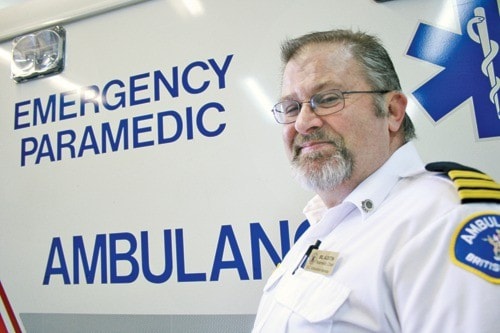Bil Austin will never forget the screams of a two-year-old child. Only a short time before, Austin had found her dead in a backyard fish pond.
The child had gone from cardiac arrest to having a heartbeat to breathing on her own in the back of the ambulance. Then she was fighting paramedics and screaming for her mother in the Nanaimo Regional General Hospital emergency department.
Those are the moments that stick with him.
“I’ve made my career on walking into people’s lives on the worst day of their life and trying to make it better,” said Austin. “It has been very gratifying. There are days that I’ve gone home and I wanted to cry and days where I felt like I was on top of the world.”
The chief of the Nanaimo unit, based at the Prideaux St. ambulance station, retired on April 26 after 35 years as a paramedic.
Austin, 59, started working as a part-time paramedic in Ladysmith in 1975. Prior to that he worked in a sawmill and was a first-aid attendant.
“Cutting straight board and having good quality sawdust didn’t excite me,” he said.
Being a paramedic appealed to him because he wanted to make a difference in people’s lives and the lives of their family.
In 1990, he worked in Tofino and then a year later worked at the Justice Institute in Vancouver.
At the institute, he oversaw training and equipment purchases for the communities of Campbell River, Port Alberni and Nelson, which were transitioning from the fire department overseeing ambulance services to the paramedics.
After eight months he was transferred back to Ladysmith and in 1999 he came to Nanaimo.
For the past 15 years, John Hosie, a Nanaimo paramedic, has been Austin’s partner.
“I will miss him dearly. We probably spend more time with each other than our spouses,” said Hosie. “The people of British Columbia have been very fortunate to have someone of this calibre look after them over the years.”
Hosie said Austin uses his wicked sense of humour on the job to put people at ease.
“He has the innate ability to pull off humour in the most difficult situations,” he said.
Austin said if you can make someone relax with humour, then even the bad times are easier to get through.
Some people encounter an ambulance on the road as it responds to a call and whirls past them. But what do paramedics do between calls? Austin said many paramedics visit people they know are dealing with chronic illnesses and make them a cup of tea or help them with their medication.
“We’re on the air and we’re able to be called for an emergency,” he said.
Austin remembers one paramedic who responded to a call where a wheelchair ramp to the home was falling apart. The paramedic went back on his own time and on his own dime tore the ramp off the house and built a new one.
“There are people in this profession that do that type of thing because this is what they love to do,” said Austin.
Roy Tufnail, who currently lives in Courtenay and is the unit chief in Port McNeill, replaces Austin in Nanaimo.
“It’s time for a new set of eyes and a new person to have a look at things and maybe present some new challenges,” said Austin. “It will be good for the organization and it will be good for the people here.”
During retirement, Austin plans to get into his workshop and complete construction on his home in Cedar.
He also plans to apply to become a part-time paramedic to “keep his foot in the door”. He said as a part-time paramedic he won’t have to worry about the paperwork piling up on the desk or getting paged or phoned at home.
